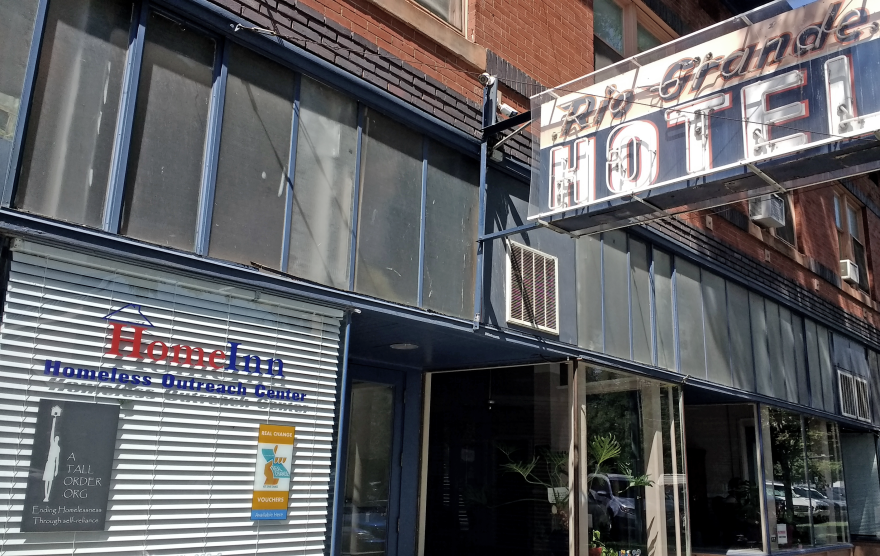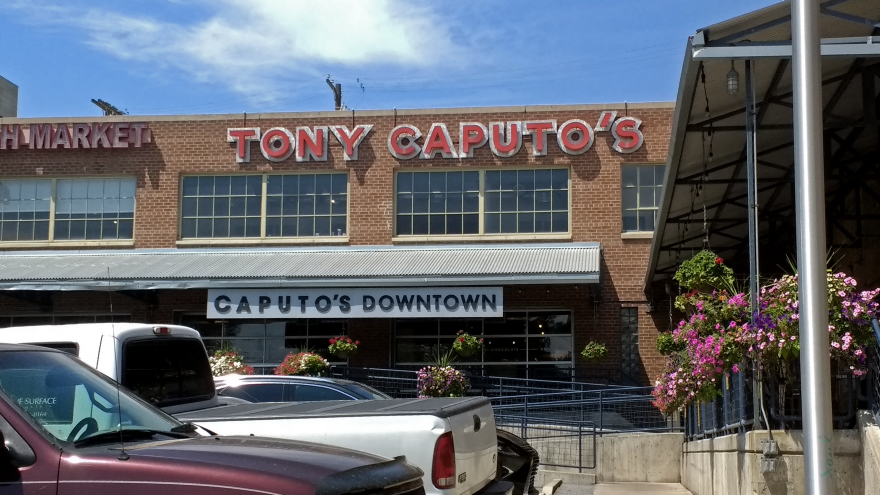Admired nationwide for its effective solutions to homelessness, Salt Lake City is now faced with a burgeoning homeless population magnified by crime, drugs and frustrations from the surrounding community.
The latest episode of violence left three injured and one dead on Tuesday.
“The best way to stay safe here in the Rio Grande District, is basically, keep to yourself. I mean there’s going to be good people, bad people -- you're going to have a lot of incidents; they’re isolated with nothing to do with you -- but you got to watch what’s going around you,” said Mike, sitting in a camping chair on a street corner. Like thousands of others living on the streets in Salt Lake City, he’s exposed to dangerous drug dealers and street gangs and relies on strained public services -- as well as his own wits -- to get by.
“If you feel a situation’s going to get bad or worse, leave the area, get on a Trax, go someplace else. You’re not trapped here, you don’t have to stay here all the time,” he said.

Those who find themselves stuck in Rio Grande can take Shelter in the Road Home, Rio Grande’s shelter with just over 1,000 beds. Despite being off the street, the Road Home can still prove dangerous. Laura Constantino was once assaulted on her way in.
“There’s just a lot of drugs and there’s a lot of securities for staff -- not for us, and there needs to be security for us too -- a lot of theft. I was walking into the Road Home and was in the breezeway and I got attacked by women with ball-peen hammer and got hit in my head and when security came out they didn’t even call 911 for me. They tried to take the hammer,” she said.
Canstantino believes the shelter’s staff can’t be of much help either.
“They’re hands are behind their back or their tied or there’s a list that’s 400 people long or you have to be here for 200 hundred days to even qualify for housing,” Constantino said.

Referring to places like the HomeInn, where guests can apply for single rooms, Constantino finds herself camped outdoors with her belongings stuffed into grocery sacks – her bed consisting of a few blankets over the concrete. Those living at the inn can work for there or find temp work elsewhere.
Paula is a bathroom attendant. After public restrooms were instated by Salt Lake County to reduce open defecation, gangs took them over and started demanding tolls. In partnership with local employment services, the city hired bathroom attendants to monitor the restrooms.
“I just monitor them after four minutes I’m supposed to knock on the doors and make sure people aren’t taking any longer than that,” Paula said. “Usually, after a couple of times of knocking, if they don’t come out, I call the Sheriff. I have a direct number to the sheriff to call; hadn’t really had to do that yet. That, and I just make sure that it's just one person going in at a time.”

Paula sits just outside the HomeInn which offers self-reliance courses. These opportunities are seen as an eventual ticket out of Rio Grande but vacancies are few and far in-between.
With the Road Home only offering a night’s stay -- booting all 1,100 occupants in the morning to clean -- that leaves many filtering onto the often times crowded streets, except in July, where the temperatures reach the high nineties most days. The stained sidewalks are littered with trash, drug items, blankets and improvised tents. To avoid build up and contamination the Salt Lake County Health Department uses tractors to scrape away and dispose of debris.
They then spray the street.

“The water is so bacteria ridden that they have to suck it back up, they’re not allowed to put it down the drainage,” said Scott Howell, a former state senator working to improve Rio Grande. “They have a great big tank on the back of this thing and they start about right here and they go all the way along and it’s just sad.”
Scott Howell represents the Pioneer Park Coalition, a group of business and property owners committed to solving the homeless situation around Rio Grande. They’re a part of the Salt Lake County Mayor’s committee to address homelessness and have played a major role in shaping the county’s approach.
“We’re advocating to close the shelter down because this area has had such a criminal history of drugs,” Howell said. “It’s been the place when people come into town and say, ‘Where do I get my drugs -- where do I get my dope?’ Right there in the Rio Grande area. And we’ve monitored it long enough that sometimes in the mornings we’ll see BMWs, Mercedes, and high-end Lexuses all driving through there: well-dressed businessmen to soccer moms.”
The Road Home provides “low-barrier” access to the homeless, meaning it is easy for anyone to get in and out. Howell thinks that’s what makes it a hot-bed for criminal activity.
“And your previous question about, ‘Wouldn’t it be better to keep it there as another resource?’ Absolutely not,” he said.
Both Salt Lake City and County have three new homeless resource centers in the works. While they have fewer beds than the Road Home, city and county officials hope they will have a greater impact by separating homeless populations based on their needs.
Because of the growing danger in Rio Grande, the state has stepped in -- providing funding to Salt Lake City and the County.
“The week prior to the Fourth of July holiday, had a meeting with stakeholders up at the capitol and I was told that the situation here at the Rio Grande area is the worst it’s ever been,” said Republican House Speaker Greg Hughes. He’s been keeping a close eye on Rio Grande following several recent controversies in July. “Then we walk from that meeting into that Fourth of July holiday, where we had a professional baseball player his head cracked open with a tire iron. That same holiday, you had someone drive over the sidewalk, killing one, injuring four.”

Hughes is currently working on a plan which will allow for greater monitoring and police enforcement.
“We need to know who people are so we can help them and for those who are breaking the law committing crimes, violence, drug dealing, they need to be arrested, they need to be processed,” Hughes said. “And when people find out that the come here that their photographs are going be taken, we’re going to have fingerprints, we’re going to run it through a national database I think that those numbers would go down naturally as well.”
The drugs and crime situation at Rio Grande has affected neighboring businesses.

“You can’t dial 911 every time there’s a spooky guy in here that we feel like we need to throw out but sometimes they can turn on a dime and they’ll get up in someone’s face and tell our 105-pound cashier that they’re going to slit her throat. At that point it’s ok to dial 9-11 but at that point sometimes it’s too late,” said Tony Caputo, owner of a popular downtown deli. He’s had to fend off multiple violent individuals wandering in to his store from the street.
Several business have been forced to move away from the area around Pioneer Park and the Rio Grande District, including Gateway Bridal and Prom. Claire Safeer, a designer with Gateway Bridal and Prom said, despite the potential danger posed by strangers around Downtown Salt Lake, it’s import to exercise compassion.
“For the most part, I feel like people just need to remember that everyone on the streets here are human as well and fallible,” Safeer said. “And just because they’ve made different failing choices than you have doesn’t mean that you haven’t made poor choices in your life and sometimes it’s the best choice they can make right now. At the same time I understand the feeling that your community is being invaded by something negative because I’ve felt that encroaching over the last couple of years, but it’s hard when you put the blame on the actual humans that you see.”


